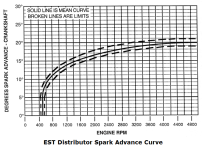So I spent a lot of time investigating the marine EST ignition timing curve by running the engine in the water under load and measuring the timing with an advance timing light. I also discussed my findings with the EST distributor manufacturer (United Marine). The result is that the EST timing curve given to me earlier (the one I posted earlier in this thread) is totally bogus. It does not represent the true timing advance curve for the EST ignition. When I questioned the manufacturer about this, he mentioned it would probably be a good idea to remove the timing advance curve from the published documentation (LOL, you think so!). I thought it interesting that his solution was to remove the curve, rather than correct it.
As it turns out, the timing curve (at least for the EST ignition module in my distributor - the ACDelco D1965A) is a straight line with no upper limit. It is simply a linear function of RPM with a slope of about 0.00518 degrees of advance per RPM. You have to adjust the base timing such that the total advance at wide open throttle (WOT) is the max total advance that you desire. In my case, the base timing turns out to be 2 degrees BTDC. Note that the published EST base timing for my 7.4L engine is 10 degrees BTDC. A base timing value of 2 degrees BTDC gives me 28 degrees total advance at 4500 RPM. 28 degrees is the highest advance that I can use with 86 octane fuel without misfiring due to predetonation. One can probably use a higher base timing value if you use higher octane fuel.
My conclusion is that one must set the base timing value for the EST ignition such that you achieve the desired maximum timing advance at WOT RPM.
WARNING: There is no timing advance limit built into the EST ignition, i.e. the timing advance curve does not "flatten" at high RPMs. The curve continues to increase at the same rate as RPMs increase without limit. In my mind, that is the biggest takeaway from this exercise.




















